Culture of Hungary
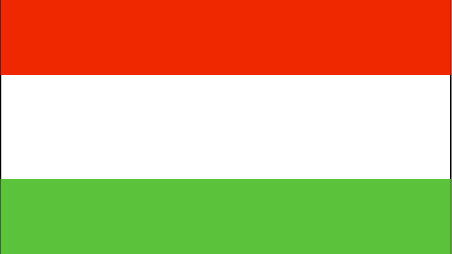
Culture Name
Hungarian
Alternative Names
Magyar
Orientation
Identification. Hungarian derives from Onogur, a Bulgarian-Turkish tribe's self-name. Between the sixth and eight centuries C.E. , both the Hungarian tribes and the Onogurs lived just northeast of the Black Sea.
Location and Geography. Hungary is a landlocked country in central Europe. Covering an area of 35,934 square miles (93,030 square kilometers), the country is in the Carpathian Basin, surrounded by the Carpathian Mountains, the Alps, and the Dinaric Alps. The Danube River divides Hungary and bisects the capital, Budapest. Hungary lies within the temperate zone and has four distinct seasons.
Demography. Hungary has lost population since the early 1980s. The population was 10,065,000 in 1999, 48,000 less than it had been a year earlier. As in several European countries, the population of the elderly is on the rise and that of children on the decrease.
The officially recognized minorities are Armenians, Bulgarians, Croats, Germans, Greeks, Poles, Romanians, Roma (Gypsy), Ruthenians, Serbs, Slovaks, Slovenes, and Ukrainians. The largest minority is the Roma, who make up about 5 percent of the population, numbering approximately 500,000. The second largest minority are the Germans, who number an estimated 170,000. There are 80,000 to 110,000 Slovaks as well as about 35,000 Croatians, 15,000 to 25,000 Romanians, 80,000 to 100,000 Jews, and 5,000 Serbs.
Linguistic Affiliation. Hungarian belongs to the Ugor branch of the Finno-Ugric language family. Before World War II, German was the most important and frequently used second language. During the socialist period, Russian was mandatory in schools and universities. English has become the most valued second language, particularly for younger people with entrepreneurial ambitions and in academia, the sciences, and various businesses and services.
Symbolism. The Hungarian language constitutes one of the most significant national symbols. History also has a central meaning in national awareness and identity. Related to history is the national coat of arms, which depicts the House of Árpád's Árpád led the Hungarian conquest in 896 C.E. and his offspring founded the state and ruled until the male line died out in the early fourteenth century. On this family crest is the crown that national tradition connects with the person of King István (997–1038) (Saint Stephen), the country's first Christian king.
This crown, usually called Sacred Crown or Holy Crown, has always been endowed with a mystical and transcendent meaning. Historically, the crown validated and legitimated the ruler. Even though the kingdom of Hungary ceased to exist in 1918, the crown continues to hold deeply meaningful national significance.
The red, white, and green flag also is a powerful national symbol. The national anthem, written in 1823, is symbol of the eastern origins and history of the Hungarians in the form of a prayer that begs God to help the nation.
The gigantic painting entitled "The Arrival of the Hungarians" is another national symbol. Feszty originally painted it for the millennial celebration (1896).
The most significant manifestation of national unity is the sense of linguistic and cultural connection that includes the national language, literature,
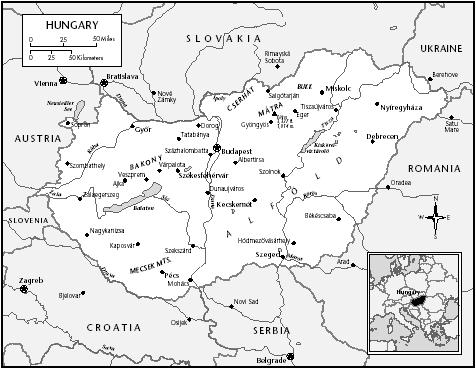
Hungary
music, folk culture, folk literature, folk traditions, and history.
A deep, permeating consciousness is another integral element of national identity. It can be summarized as "we are all alone" and is based on historical reasons and the "otherness" of the language and the origins of Hungarians. While the consciousness of "we are all alone" was dormant during the socialist period (1948–1989), it still remained a recognizable and crucial part of the national identity.
History and Ethnic Relations
Emergence of the Nation. There is evidence that the Hungarian nation was a unit in the Middle Ages. In Latin chronicles dating back to the tenth century, there are colorful origin myths of the Hungarians "conquering" and occupying the Carpathian Basin and their conversion to Christianity under King Stephen. Many Hungarians consider their nation "the final fortress of Western Christianity and civilized Europe."
National Identity. In the Middle Ages, groups and nationalities that were not ethnically Hungarian lived in the nation. After the late Middle Ages, a dual national consciousness is demonstrable. On the one hand, there was a nation–state that ethnic Hungarians and non-Hungarians could share. On the other hand, there was a narrower sense of belonging to the Hungarian linguistic, cultural, and ethnic community.
In 1526, a young Hungarian king fell in a battle with the Ottoman Turks. On the basis of a marriage contract, the Habsburgs claimed the Hungarian throne. After conquering the Ottomans in 1686 and 1712, the Habsburgs ruled all of Hungary. The population accepted their right to rule but kept and observed their own laws, legislative powers, parliament, and administrative division. From time to
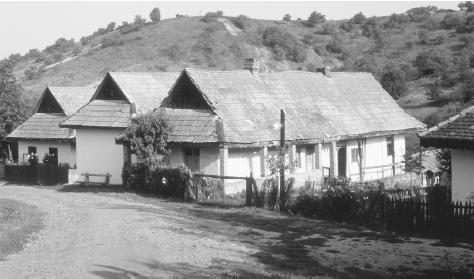
Houses in the village Holloko in northern Hungary in 1980. At the end of the twentieth century more than half of Hungarians grew food for their own use and for supplemental income.
time there were anti-Habsburg revolts, conspiracies, and political unrest.
In 1848, a revolution led by Lajos Kossuth demanded democratic reforms and more independence from Austria. However, Austria defeated the revolution. This was the first time that the general population, including the peasantry, experienced a sense of national unity. While some of the nationalities shared that experience, most turned against the Hungarians.
The Austrian tyranny that followed the revolution of 1848 ended with the 1867 Austrian-Hungarian Compromise. With this accord, the Austro-Hungarian monarchy was established. The Austro-Hungarian monarchy ended after World War I. The Trianon Treaty of 1920 ended the territorial integrity of Hungary. Nearly 70 percent of its historical territory and 58 percent of its former population were ceded to neighboring countries. One-third of ethnic Hungarians came under foreign rule. With the assent of the Western powers, Hungary came under Soviet occupation after World War II. Under the leadership of Moscow and the Moscow-led Hungarian Communist Party, the "building of socialism" began. In 1956, the nation rose up against the Communist rule and occupation by the Soviet Union. The revolt was defeated and approximately two hundred thousand Hungarians, mostly young people, skilled workers, white-collar workers, professionals, and intellectuals, escaped to the West.
By 1968 Hungary had become the "happiest barrack in the lager" as a result of the economic reforms of the New Economic Mechanism and with some social and political liberalization. In 1989, Hungary was the first Socialist Bloc country to open the "Iron Curtain," providing a transit route for thousands people emigrating from East Germany to West Germany, precipitating the fall of the Berlin Wall and the reunification of Germany.
The "softer" regime under János Kádár was successful in weakening traditional national consciousness, along with previously closely knit community networks and religious worldviews and values. After forty years of socialism, the general tendency among many in the population is to be individualistic, survival-oriented, and likely to work out strategies of compromise.
Ethnic Relations. After the 1989 change of regime, the Hungarian government assumed responsibility for the ethnic and linguistic maintenance of ethnic Hungarians living outside the nation's borders. The government tries to establish and maintain fair and friendly relations with the governments of neighboring countries. There are frequent complaints, however, that the Hungarian minorities' ethnic and cultural maintenance is made difficult by the host countries.
Hungary continues to strive for friendly relations with the surrounding countries. Ethnic and national minorities are encouraged to set up their own self-governing councils, and their cultural and educational institutions receive state support.
Among the minorities, the Roma are in an extremely difficult situation. Their high birth rate, disadvantageous economic position and social status, and the subjection to prejudice have worsened their economic circumstances and social integration.
Urbanism,Architecture, and the Use of Space
Until the middle of the nineteenth century, Hungary was a primarily rural agrarian society. Often Hungarian villages had large populations. The church was always in the center of the village. Many settlements were "two-church villages," indicating that two groups settled there at different periods.
On the Great Hungarian Plain instead of villages, there was a loose network of huge agrotowns that were located far from one another, each with a population from 20,000 to 100,000. Until recently, most Hungarians engaged in agriculture. The large agrotowns were administered as villages, with most of their inhabitants living like peasants. In the early eighteenth century, individual, isolated homesteads sprang up. Only seasonally occupied at first, they eventually became permanent residences of mostly extended families. However, even though about 50 percent of the people in the agrotowns lived and worked outside towns on these homesteads, they still considered themselves townspeople.
As a result of industrialization after the establishment of the Austro-Hungarian monarchy in 1867, a number of industrial-commercial-merchant cities sprang up. Between 1867 and the beginning of World War I, Budapest grew into a huge metropolis with a population of over a million.
In the center of cities there are city halls and other public buildings as well as churches, shopping districts, and remnants of traditional marketplaces. Some churchyards still have small cemeteries.
Until recently, it was customary to have a tiszta szoba (clean room) in peasant houses that was used mainly for special visits and particular rituals and occasions such as births, christenings, weddings, and funerals. There were also "sacred corners" that were decorated with pictures of various saints and pictures and statues brought back from Catholic pilgrimages. In Protestant households, the walls of those rooms depicted religious reformers and the heroes of the 1848 revolution.
Food and Economy
Food in Daily Life. Magyar kenyér (Hungarian bread) remains very important in the rural and urban cuisine. For the last one hundred fifty years, wheat has been one of the most important crops both for domestic use and exportation. Pig breeding became the most important type of animal breeding in the 1870s, and since then the meat and byproducts of pigs have predominated in the national diet.
Food Customs at Ceremonial Occasions. The cuisine at most village weddings includes chicken soup with special csiga noodles that were traditionally believed to have fertility-inducing properties, gulyás , stuffed cabbage, sweetened millet, sweetened rice and other rice dishes, and butter-cream tortes and other baked goods.
According to the national self-image, Hungarians are wine drinkers, but beer drinking is more common. Since the early 1990s there has been an attempt to familiarize the population with regional wines.
Basic Economy. Before World War II, Hungary was an agricultural country. During the socialist regime, forced industrialization took place. However, more than half the population does some agricultural work for household use and supplemental income.
Major Industries. Tourism continues to be a great Hungarian success. The production of barley, corn, potatoes, wheat, sugar beets, and sunflower seeds, along with grapes and wine making, is important. Mines are no longer subsidized by the government, and many mines have closed.
Trade. Imports include metal ores and crude petroleum, while exports include agricultural products, consumer goods, leather shoes, machinery, transport equipment, chemicals, textiles, wines, iron, and steel.
Between 1948 and 1989, more than half of foreign trade was with the Soviet Union and other socialist countries. Since the early 1990s, foreign
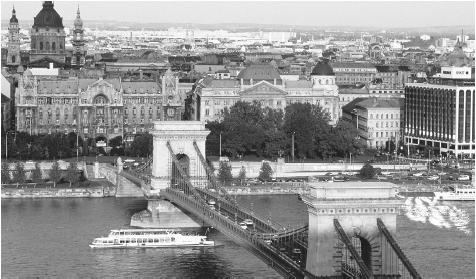
The towns of Buda and Pest (shown in 1995), on opposite sides of the Danube River, joined to become Budapest in 1873.
trading partners have been Germany, Italy, Austria, the United States, and some of the formerly socialist countries.
Social Stratification
Classes and Castes. Early in the socialist period, the nationalization of industries, commerce, and most services, along with the forced collectivization of agrarian landholding, brought about the end of private property. Communist Party leaders, secretaries, and members lived better and had access to more goods than did the rest of the population. Privatization of industry, commerce, and some services took place after 1990 as Western capital flowed into Hungary. As a result of a complex and controversial system of property compensation, most arable land and real properties were reprivatized after more than four decades. The income gap then widened between the rich and the poor. It increased in 1998 as 38 percent of the population earned below the minimum annual wage. In contrast, the rich seem to have increased their wealth at a rapid rate.
Upward social mobility still depends on the channeling of students into educational institutes. A disproportionate number of students in high schools, colleges, and universities come from intellectual, upper management, or otherwise "elite" families.
Symbols of Social Stratification. Western-style clothes, especially American jeans, are worn by the bulk of the younger population in both urban and rural areas. New clothes are very expensive and brand names such as Levi-Strauss can be bought only by a small segment of the population. Shiny polyester or nylon leisure suits worn with expensive, name-brand sports shoes are signs of new and successful entrepreneurs. Many of the new rich drive expensive foreign cars. The number of cell phones and their frequent and public uses are striking. There are numerous luxurious new or elaborately remodeled villas in Budapest that are owned by the new economic elite. Foreign travel has become a flaunted symbol of wealth and status.
Political Life
Government. All levels of government were under the control of the Communist Party between 1948 and 1989. The change of regime in 1989 brought in a multiparty government and a parliamentary democracy with elected representatives. At the end of the twentieth century, there were 182 officially registered political parties.
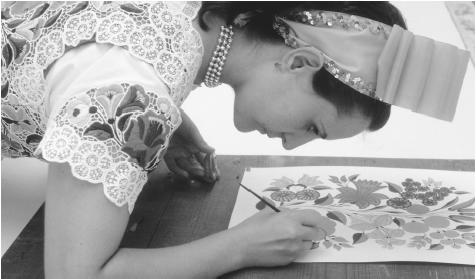
A woman paints a flower design which will be used to make a traditional Hungarian dress in Kalocsa, Hungary.
Leadership and Political Officials. There is a president, who is the head of the state and may be elected for two five-year terms. The prime minister is the leader of the party with the most seats. The parliament is called the National Assembly, with 386 deputies who are elected for four-year terms. The Constitutional Court was established in 1990. There is a Judicial Supreme Court that is essentially a final court of appeal.
Social Problems and Control. Alcoholism is a widespread and significant problem. In addition, drug abuse has increased since the end of the socialist regime. After the outbreak of the war in the former Yugoslavia in 1991, Hungary became a favorite place for international organized crime organizations that engage in drug, weapons, and people smuggling; prostitution rings; and money laundering. The crime rate is rapidly increasing. The population worries about the lack of public safety and generally blames crimes on the Roma as well as refugees and other foreigners. Psychological problems, particularly depression, increased significantly between 1988 and 1996, and, although the number of suicides has been declining, Hungary continues to have the highest rate of suicide in the world.
Military Activity. Modernization of the army began in the early transition period (1990–1994) and has continued since the country has become part of the North Atlantic Treaty Organization (NATO). There is an ongoing process of integrating the Hungarian armed forces with NATO organizations and the filling of alliance posts. The army is being converted to a mixed structure that is composed of volunteers and conscripts. All males between ages 18 and 55 are required to serve in the armed forces, but conscription is selective. For example, students in universities serve for a very short time or not at all and conscientious objectors are given civilian jobs. There are 80,000 people serving in the army, air force, border guards, and the small fleet guarding the Danube River.
Gender Roles and Statuses
Division of Labor by Gender. Men are expected to work, earn, and provide for their families, while women are expected to take care of the children and the domestic chores. These ideal roles are rarely achieved today. In the last couple of generations, the rate of divorce and remarriage has increased dramatically. Since the change of regime (in 1989), cohabitation of unmarried couples and the number of children born outside of marriage have grown. These patterns are more common among those with less formal education, money, and social prestige.
Most Hungarian men do not help with the housework, and few women object to this arrangement. Only among a small percentage of young, mostly urban couples and an even smaller segment of middle-aged intellectuals and professionals is there evidence of a changing pattern in the gendered division of labor in the domestic sphere.
The Relative Status of Women and Men. The images of the mother and motherland are expressed in the national literature and culture. Since the early nineteenth century, the centrality of the mother-son relationship has been idealized in literature and the public consciousness. The mother is often hailed as the core of the national identity, the guardian and cultivator of a "real" culture that is untouched by foreign influences.
Marriage,Family, and Kinship
Marriage. Marriages are no longer arranged. Young people usually marry for love or to have children. The perpetual shortage of apartments is a problem for married couples. Young married couples frequently move into the small apartment of either set of parents. While traditionally a young married couple lived near the parents of the groom, today, if a couple cannot set up an independent new household, they move in with the set of parents who will welcome them and has the most room. Most households consist of a married or unmarried couple and their children.
Even when a couple lives in a separate household, great value is placed on having the help of a grandmother or grandfather.
Kin Groups. Kin groups are often large in villages and smaller in urban centers. Godparenthood is still much valued. Extended families living in the same household are very rare.
Socialization
Infant Care. Traditionally, newborns were swaddled; today they are wrapped in warm blankets when they are very young, but swaddling is no longer practiced. Infants and toddlers are usually put into a separate space to sleep and play. Parents try to calm an active baby rather than stimulate it. There seems to be a growing child centeredness that is manifested in focusing on children and often giving them more material goods and privileges than the family can afford. Good children are obedient, mindful, diligent, respectful, industrious, quiet, and good students. In rural areas, more emphasis is placed on respect and industrious behavior. The actual behavior of children rarely approximates these expectations.
Child Rearing and Education. Formal education is compulsory between six and sixteen years of age. The rate of literacy is 98 percent. Traditionally, most people considered a high school diploma as the final formal educational goal.
Higher Education. Since the 1980s more value has been placed on college or university education. This is illustrated by a slightly increased enrollment in colleges and universities and in an expansion of educational opportunities in institutes of higher learning.
Etiquette
Hospitality entails an extraordinary effort to feed and care for guests. Guests are always encouraged to step into one's home first.
On the streets, it is customary for men to walk on the left side of women, ostensibly because in the past gentlemen kept their swords on the left side and women had to be on the opposite side of the sword. A Hungarian man enters first into a pub, restaurant, coffeehouse, or other public establishment.
Friends, family members, and close acquaintances who have not seen one another for a while greet and part from one another with pecks on both the left and right cheeks. Touching the hands, arms, and shoulders of partners in conversation is common. It is customary for a woman to offer her hand first both to men of all ages and to younger women and children.
Differentiated formal terms of address are seldom used among younger people. Informal styles of greeting and terms of address are used from the moment of initial meeting. Considerably less time is spent visiting and socializing in coffeehouses and on the streets than in the past.
Bodily contact is rather intimate on public transportation and in malls and shopping centers. In isolated rural settlements, villagers still stare at strangers.
Religion
Religious Beliefs. According to surveys in the early 1990s, 72 percent of Hungarians are Roman Catholic, 21 percent are Calvinist Reformed, 4 percent are Lutherans, nearly 1 percent are Jewish, and
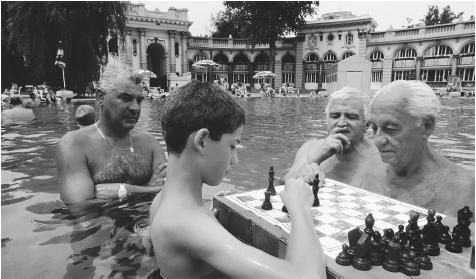
Hungarians frequent the Szechenyi Thermal Baths in Budapest and other spas to promote good health.
about 2 percent are "nondenominational" or "other."
After Russia, Hungary has the largest Jewish population in its region. About 80 percent of Hungarian Jews live in the capital city. About half the Jewish population is over the age of 65.
There was an official campaign against all religions during the socialist regime. Those who openly practiced a religion were discriminated against and often punished. The state closed most parochial schools and dissolved or disbanded religious orders and institutions. After 1989 and during the periods of privatization, many schools and other formerly parochial buildings were returned to the churches. As compensation for the confiscated properties, the state financially supports parochial schools and other religious institutions.
Among large segments of the population, religious indifference and often explicitly antireligious attitudes prevail. This is an outcome of the lax, individualist, atomizing policies of the last decade of socialism. Alongside the major denominations, there are an increasing number of small sects, religious movements, and Eastern religious practices, along with a growing number of followers of proselytizing Western missionaries.
Many Hungarians do not formally belong to or regularly practice any religion, but baptisms, weddings, and funerals tie them informally to churches.
Rituals and Holy Places. Among the sacred places of the Hungarian Roman Catholic Church are the city of Esztergom, where Saint Stephen was born; Pannonhalma, where the first Benedictine Order was founded in 996 C.E. ; the city of Eger; and a number of provincial rural settlements and places of annual pilgrimage. Calvinists in eastern Hungary consider Debrecen the "Calvinist Rome." The religious centers for Lutherans are Budapest and Sopron. Budapest has the largest synagogue in Europe.
Death and the Afterlife. In addition to traditional in-ground burial, cremation with special places to put funerary urns has been practiced since before World War II. Because of a lack of cemetery space in the cities and the great expense of traditional funerals, cremation is widely practiced.
Medicine and Health Care
Western medicine is practiced, although many individuals have turned to alternative medicine such as acupuncture and herbal and homeopathic remedies. In addition to Western medical treatment, frequenting medicinal spas, getting professional deep tissue and other types of massage, and drinking mineral water continue to be very popular.
Secular Celebrations
Major national holidays include 20 August, commemorating the death of King Stephen. This day is also an ecclesiastical feast day. During the socialist regime (1948–1989), 20 August was renamed the Day of the Constitution and the Day of New Bread. Another major national holiday is 15 March, which commemorates the bloodless democratic civil revolution that broke out in 1848. Since the change of regime in 1989, 23 October has been a day of remembrance of the revolution of 1956, when Hungarians rose against the Soviet occupation. Though not an official holiday, the Day of the Martyrs of Arad (6 October) is a significant time of remembrance.
In addition, there are numerous local memorial celebrations, art festivals, and folk festivals. Among the many festivals and fairs are the southern Folklore Festival along the Danube, the northern region's annual Palóc Festival, and the annual Bridge Fair. In the annual Budapest Spring Festival, there are art exhibits and musical and theatrical events.
The Arts and Humanities
Support for the Arts. Support for the arts during the socialist period was provided primarily by the State. Since 1989, there has been much less governmental support and more private, individual, and corporate sponsors for artists.
The State of the Physical and Social Sciences
The physical and social sciences are taught on sophisticated and advanced levels in universities, research facilities, and other institutes. State funding continues to be a key resource, but it has decreased in the last decade. There has been a "brain drain" as younger and middle-aged scientists leave temporarily or permanently for better wages and opportunities and more advanced laboratories and instruments in Western Europe, the United States, Canada, and Australia.
Bibliography
Bárány, George. Stephen Széchenyi and the Awakening of Hungarian Nationalism . 1968.
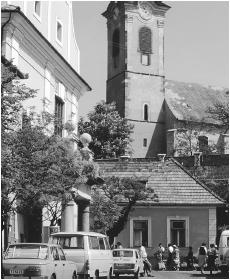
Remnants of past centuries such as this clock tower still dominate many towns.
——. "Hungary: From Aristocratic to Proletarian Nationalism." In Peter Sugar and Ivo Lederer, eds., Nationalism in Eastern Europe , 1969.
Bibó, István. Democracy, Revolution, Self-Determination. Selected Writings , 1991.
Csalog, Zsolt. "'We Offer Our Love': Gypsies in Hungary." New Hungarian Quarterly 33, (127):70–80, 1992.
Csepeli, György. Structures and Contents of Hungarian National Identity: Results of Political Socialization and Cultivation, , 1989.
——. National Identity in Contemporary Hungary , 1997.
Crowe, David. "The Gypsies of Hungary." In David Crowe and J. Kolsti, eds., The Gypsies of Eastern Europe , 1990.
Deák, István. "Uncovering Eastern Europe's Dark History." Orbis , Winter 1990.
——. Beyond Nationalism: A Social and Political History of the Habsburg Officer Corps, , 1992.
Erõs, Ferenc. "The Construction of Jewish Identity in Hungary in the 1980s." In Ferenc Erõs, David Schers, and David Zisenwine, eds., Yitzak Kashti, A Quest for Identity: Post War Jewish Biographies. Studies in Jewish Culture, Identity and Community, School of Education , 1996.
Fél, Edit, and Hofer Tamás. Proper Peasants: Tradtional Life in a Hungarian Village , 1969.
Fenyõ, MarióD. Hitler, Horthy and Hungary , 1972.
Gerõ, András. Modern Hungarian Society , 1995.
Gombár, Csaba, Elemér Hankiss, László Lengyel, and György Várnai, eds. The Appeal of Sovereignty: Hungary, Austria, and Russia , 1998.
Hanák, Peter, ed. The Corvina History of Hungary: From Earliest Times Until the Present Day , 1991.
Hofer, Tamás, and Edit Fél. Hungarian Folk Art , 1979.
Huseby-Darvas, Éva. "The Search for Hungarian National Identity." In Lola Romanucci-Ross and George DeVos, eds., 1995.
——. "'Feminism, the Murderer of Mothers': Neo-Nationalist Reconstruction of Gender in Hungary." In Brackette F. Williams, ed., Women out of Place: The Gender of Agency and the Race of Nationality , 1996.
János, Andrew. The Politics of Backwardness in Hungary , 1982.
Jászi, Oszkár. The Dissolution of the Habsburg Monarchy , 2nd ed., 1958.
Kereszty, András, ed. The Reliable Book of Facts Hungary '98 , 1999.
Kis, János, Politics in Hungary: For a Democratic Alternative , 1989.
Kisbán, Eszter "Parasztételbôl nemzeti jelkép: A Gulyás esete 1800 körül [From Peasant Food to National Symbol: The Case of the Gulyás]." Janus IV.
Kolosi, Tamás, István G. Tóth, and György Vukovich, eds., Social Report 1998 , 1999.
Kontra, Miklós. "Hungary." In Sprachkontakte in Mitteleuropa Kontaktlinguistik, Hans Goeble, Peter H. Nelde, Zdenek Stary, and Wolfgang Wolk, eds., 1997.
Kuti, Éva. Hivjuk talán non-profitnak [Perhaps We Ought to Call It Non-Profit] , 1998.
Lázár, István. An Illustrated History of Hungary , 1995.
Lukács, John. Budapest 1900: A Historical Portrait of a City and Its Culture , 1988.
Makkai, Ádám, ed. In Quest of the Miracle Stag , 1996.
McCagg, William O. Jewish Nobles and Geniuses in Modern Hungary , 1973.
Macartney, Aylmer C. National States and National Minorities , 1934.
Örkény, Antal, and Mária Székelyi. "Justice and Legitimacy: Post-Transformation Trends in Eastern Europe." In Kolosi, Tóth, Vukovics, eds., 1999.
Szathmáry, Lajos. "How Festive Foods of the Old World Became Commonplace in the New, or the American Perception of Hungarian Gulyás." Oxford Symposium on Foods and Eating Habits Proceedings 2(1):137–143, 1983.
